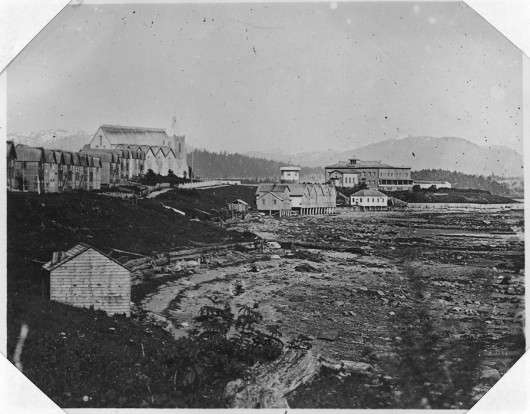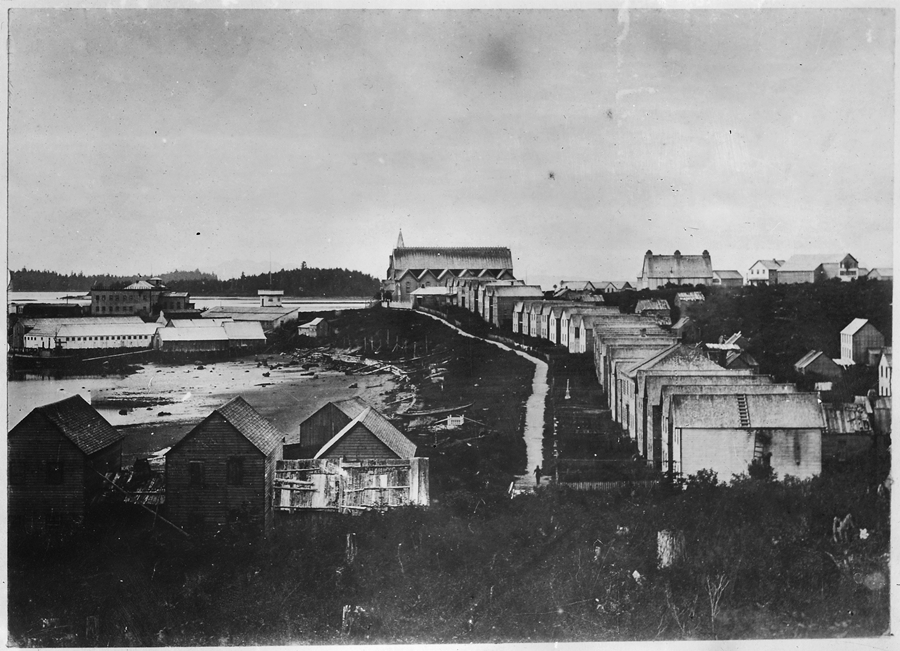Many Alaskans are not aware there are two Metlakatlas. The first is in British Columbia, a short ferry ride from Prince Rupert. It’s the original settlement founded by the followers of Anglican lay-priest William Duncan.
KRBD’s Leila Kheiry talked with an elder of that community during a trip to Prince Rupert last fall; and then with some residents of Alaska’s Metlakatla just last month, in anticipation of that Southeast city’s upcoming Founders Day celebration.
In this first of a two-part series, Tsimshian elder Clarence Nelson talks about the Canadian settlement, the stories he heard about the historic Native community, and how the Canadian and Alaska towns maintained ties over the decades.

Clarence Nelson was born in 1940, long after the Metlakatla migration from Canada to Southeast Alaska, but even at a young age, he loved hearing the stories and learning the history of his people.
Speaking at a Prince Rupert hostel that used to be a boarding school for Native girls, Nelson said that while both Metlakatlas are now primarily Tsimshian, the original settlement, built in 1862, was open to members of all First Nations people.
“It didn’t matter who you were…It was almost like a little multi-cultural community,” he said. “Different nations that wanted to become Christians. That’s how the community was built.”
Christianity was the driving force behind that community, promoted by William Duncan, a British lay-priest who never was ordained but was an important religious and community leader starting shortly after his arrival in Canada in 1856.
Duncan’s first self-imposed task, Nelson said, was learning the Tsimshian language.
“He would not hold a service for one year until he could learn to preach in our language. He wanted to perfect his tongue and using our language,” he said. “He had – they called him Clad – was his teacher. He taught Clad English, Clad taught him our language.”
Nelson said Duncan wasn’t opposed to most of the tribal traditions, except for those associated with feasts – potlatches. Duncan’s reasoning, Nelson said, was that it was a waste of money and resources.
“He said we’re giving our wealth away, which is true. But that’s the way we did things years ago,” he said.
Unlike other missionaries at the time, though, Nelson said Duncan encouraged First Nations people to retain their languages.
“That’s how he made money, too. He had Casper Mather – an elder, a preacher — he sent him to Chicago to preach and talk about how well the community is doing here in Christianity,” Nelson said. “(Mather) would preach in our language and in English. They’d come back with so much money for Duncan. That’s one of the ways Duncan raised money.”

Nelson said that money, and money from selling furs and handicrafts, went toward the community, which Duncan and his followers built on a historic village site.
“They chose that spot because it provided them with all the resources they needed,” he said. “Whether on land for animals, on the sea for clams and fish, the berries, the trees, the bark. They had everything right there. It was a … village – my tribe. Duncan renamed it Metlakatla.”
About 1,200 people lived in that community, and the church was big enough for them all.
“And if there wasn’t 1,200 people in church on a Sunday, Duncan would send a constable down to see what’s wrong with this person,” he said. “People had to have a pretty darned good excuse to not come to church. That’s how strong that community was in Christianity.”
There were more than two dozen constables in the original Metlakatla, and Nelson said trading ships coming through the area were searched in case they contained alcohol, which was prohibited.
The community had schools and technical training, Nelson said, and a lot of talented musicians. It was self-sustaining and prosperous, which he said is partly why the Church of England decided it needed to take control from Duncan and the people who lived there.
That move by the church, accompanied by the government’s move to take more land from the tribes and stamp out indigenous language and culture, prompted more than 800 people in Metlakatla to leave, and move to Annette Island in Southeast Alaska in 1887.
Nelson said those who left were the most devoted followers of William Duncan, and were the most deeply religious of the community.
“There were 800 followers that were dedicated to Duncan,” he said. “They seen what he had done – built a whole Christian community with homes like they never had before, schools, industry and they had their own store – they didn’t have to go to Hudson Bay (Trading Co.) to trade.”
But, hundreds also stayed behind in Canada, separating many families. Those family ties kept the two communities connected, even through today.
“My brother in Metlakatla, Alaska, has 53 grandchildren,” he said. “My sister here has 45, so we’ve got a huge family.”
And those in Alaska were able to maintain their membership in the Canadian tribe, he said, which allowed them to visit back and forth easily.
Historically, residents of the two Metlakatlas visited for music performances and family events. In more recent years, it was basketball.
“They’d usually come down every year – that all-Native tournament game brings people together,” he said.
Nelson said it’s taken a long time, but Canada’s Metlakatla has been slowly bringing back its First Nations traditions – a process Alaska’s Metlakatla started in the 1980s.
Nelson’s wife is one of the few fluent speakers of the Tsimshian language, and she teaches it in the schools; and the small historic village on a lush island outside of Prince Rupert now has a totem pole.
“That’s the first pole in almost 200 years that we raised,” he said.
And Nelson, who loves to tell stories, will do his best to make sure as many people as possible understand the rich history of his Metlakatla.




